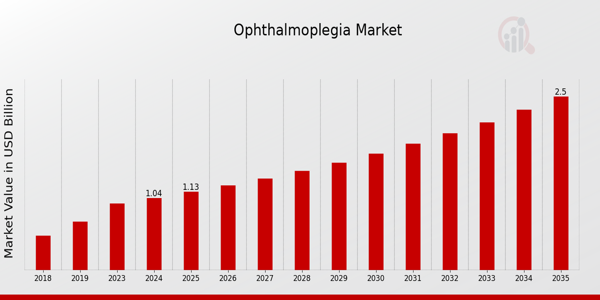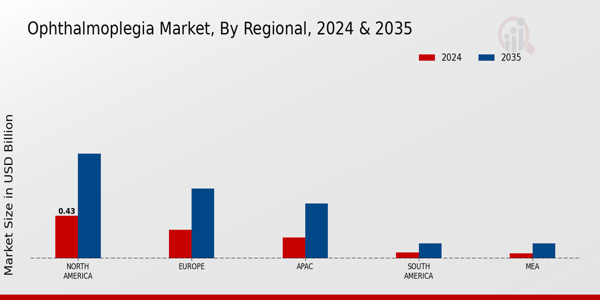Ophthalmoplegia Market Overview
As per MRFR analysis, the Ophthalmoplegia Market Size was estimated at 0.96 (USD Billion) in 2023. The Ophthalmoplegia Market Industry is expected to grow from 1.04(USD Billion) in 2024 to 2.5 (USD Billion) by 2035. The Ophthalmoplegia Market CAGR (growth rate) is expected to be around 8.28% during the forecast period (2025 - 2035).
Key Ophthalmoplegia Market Trends Highlighted
The Global Ophthalmoplegia Market is experiencing notable growth driven by increasing awareness of the condition and advancements in treatment options. One key market driver is the rising incidence of ophthalmoplegia due to various underlying causes such as neurological disorders, traumatic injuries, and infections.
This awareness is fostering the demand for accurate diagnosis and effective treatment modalities. Additionally, advancements in imaging technology and neurological assessments are facilitating early detection, which can lead to better patient outcomes. Opportunities in the Global market include the development of innovative therapies and rehabilitation options aimed at addressing the diverse needs of patients affected by ophthalmoplegia.
Modern approaches, including telehealth and mobile health applications, are being integrated by healthcare providers in order to improve patient engagement and accessibility, as the emphasis is placed on patient-centered care.
The improvement of healthcare infrastructure and the increase in investment in the neurology sector are also identified as critical areas for growth in emerging markets. The trend of personalized medicine has acquired momentum in recent years, specifically catering to the unique requirements of ophthalmoplegia patients.
Recovery rates and overall satisfaction can be substantially improved by customized treatment plans that are based on the unique characteristics of each patient. Additionally, the collaborative endeavors of researchers, clinicians, and technology developers are resulting in the development of innovative therapeutic modalities, such as neurostimulation devices and gene therapies, which are anticipated to substantially alter the treatment paradigms in ophthalmoplegia.
A positive outlook for the Global Ophthalmoplegia Market is indicated by the continuing evolution of treatment strategies and the increasing emphasis on rehabilitation services.

Source: Primary Research, Secondary Research, MRFR Database and Analyst Review
Ophthalmoplegia Market Drivers
Increasing Prevalence of Neurological Disorders
The Global Ophthalmoplegia Market Industry is significantly driven by the increasing prevalence of neurological disorders that lead to conditions such as ophthalmoplegia. According to data from the World Health Organization, neurological disorders affect approximately 1 in 6 people globally, with an estimated 50 million individuals suffering from epilepsy and around 7 million from stroke annually. These conditions often result in complications, including ophthalmoplegia, thereby increasing the demand for diagnostic and therapeutic solutions.
In addition, organizations like the American Academy of Neurology contribute to the awareness and management of these disorders, pushing for innovations in treatment options that further fuel market expansion.
The healthcare market's focus on addressing these neurological conditions is set to grow, leading to substantial investment in Research and Development (R) for effective ophthalmoplegia therapies as public health policies increasingly emphasize the importance of chronic disease management.
Advancements in Medical Technology
Technological advancements in the field of ophthalmology play a pivotal role in the growth of the Global Ophthalmoplegia Market Industry. Recent developments in imaging techniques and surgical procedures have transformed diagnosis and treatment. For instance, the introduction of high-resolution optical coherence tomography (OCT) has improved the detection of structural changes associated with ophthalmoplegia.
Industry leaders like Johnson Johnson and Alcon are investing heavily in these innovative technologies.
As outlined by the Food and Drug Administration, the approval of novel diagnostic devices and therapeutic methods is on the rise, demonstrating a commitment to enhanced patient care. This momentum in technology ultimately leads to an increased patient reach and revenue generation, thereby propelling the market forward.
Growing Awareness and Patient Advocacy
The Global Ophthalmoplegia Market Industry has seen increased growth due to the rising awareness and advocacy for understanding and treating eye movement disorders. Advocacy groups such as the American Academy of Ophthalmology play a significant role in educating the public about conditions that lead to ophthalmoplegia. Public campaigns have highlighted the importance of early diagnosis and treatment, leading to more patients seeking medical assistance.
According to health surveys, approximately 70% of individuals become aware of health issues through educational initiatives, which boosts early intervention statistics. This shift in patient behavior encourages healthcare providers to prioritize the development of specialized treatment protocols, directly impacting market expansion and increasing the demand for innovative therapies.
Ophthalmoplegia Market Segment Insights
Ophthalmoplegia Market Type of Ophthalmoplegia Insights
The Global Ophthalmoplegia Market is witnessing significant expansion, particularly within the Type of Ophthalmoplegia segment, which encompasses various conditions affecting eye muscle function.
By 2024, the segment is expected to contribute substantially, with categories such as Congenital Ophthalmoplegia valued at 0.25 USD Billion and Acquired Ophthalmoplegia at 0.41 USD Billion. Acquired Ophthalmoplegia notably dominates this segment, reflecting its higher prevalence driven by factors such as trauma, diabetes, or disease, expected to reach 1.0 USD Billion by 2035, thus illustrating its importance in the market.
In addition, Botulism Ophthalmoplegia is projected to grow from 0.2 USD Billion in 2024 to 0.4 USD Billion in 2035, attributed to increased awareness and diagnosis of botulism-related complications. Thyroid Eye Disease, which accounts for a valuation of 0.18 USD Billion in 2024 and may reach 0.45 USD Billion in 2035, represents an important concern due to thyroid dysfunction impacting vision, thus creating opportunities in targeted therapies.
Overall, these key segments highlight the varied nature of ophthalmoplegic disorders, each playing a vital role in the Global Ophthalmoplegia Market revenue growth and addressing distinct patient care needs.
Moreover, the increase in prevalence rates across these conditions can be linked to rising chronic health issues, as well as an aging population, presenting significant challenges and opportunities for healthcare providers and stakeholders within the ophthalmic sector.
This dynamic landscape indicates that the market is poised for substantial growth, reflecting an urgent need for innovative management strategies and treatment options tailored to each type of ophthalmoplegia.
Thus, understanding the segmentation of the Global Ophthalmoplegia Market becomes essential for developing industry strategies that meet both current and evolving consumer demands.

Source: Primary Research, Secondary Research, MRFR Database and Analyst Review
Ophthalmoplegia Market Symptoms Insights
The Global Ophthalmoplegia Market is expected to reach a value of 1.04 USD Billion in 2024, showcasing steady growth in the Symptoms segment. This segment includes essential manifestations such as Diplopia, Ptosis, Strabismus, and Limited Eye Movement, each playing a crucial role in the detection and understanding of ophthalmoplegia.
Diplopia, commonly known as double vision, is particularly significant as it can severely affect the quality of life, making timely diagnosis important. Ptosis, characterized by drooping eyelids, often indicates underlying neurological conditions, highlighting the critical need for awareness and targeted treatment options.
Strabismus, which involves misalignment of the eyes, not only impacts vision but can also lead to psychological effects in patients. Limited Eye Movement further underscores the condition's impact on daily functioning. The emphasis on these symptoms in the Global Ophthalmoplegia Market segmentation reflects a growing recognition of their implications, trends in healthcare, and the demand for innovative treatment solutions.
As healthcare systems globally continue to evolve, understanding these key symptoms and their relevance is central to shaping effective strategies in addressing ophthalmoplegia.
Ophthalmoplegia Market Treatment Type Insights
The Global Ophthalmoplegia Market, with an expected value of 1.04 billion USD in 2024, is experiencing significant growth within the Treatment Type segment. This segment includes various treatment approaches such as Surgical Intervention, Medication, and Physical Therapy, each playing a crucial role in managing ophthalmoplegia. Surgical Intervention is often considered imperative for severe cases where structural correction is essential, thus having a dominantly substantial impact on patient outcomes.
Medication, particularly focusing on alleviating underlying causes, remains a critical component of treatment regimens tailored to individual patient needs. Physical Therapy is gaining recognition as it provides rehabilitation support, facilitates muscle strength recovery, and improves overall function.
The combination of these treatment types reflects a comprehensive approach in the Global Ophthalmoplegia Market industry, accommodating the diverse requirements of patients. The increasing prevalence of ophthalmoplegia and advancements in treatment methodologies are driving market growth. However, challenges such as accessibility and costs are barriers that need to be addressed. As the market evolves, there exist ample opportunities for innovation in treatment methods, indicating a robust future for this segment.
Overall, the Global Ophthalmoplegia Market data highlights the necessity of diverse treatment options to enhance quality care in this field.
Ophthalmoplegia Market End User Insights
The Global Ophthalmoplegia Market, concentrated on its End User segment, encompasses various healthcare settings where ophthalmoplegia treatments are administered. By 2024, the market is projected to achieve a value of 1.04 billion USD, reflecting the increasing demand for targeted therapies in this area. Within this segment, hospitals play a crucial role due to their capability to offer advanced medical technologies and specialized care for complex cases.
Additionally, ophthalmology clinics are gaining traction as they provide focused services tailored to ocular disorders, enhancing patient access to specialized treatment.
Home care settings are emerging as a vital option, allowing patients to receive care in a comfortable environment, thus promoting better recovery and adherence to treatment plans. The growing prevalence of ophthalmic disorders and advancements in therapies are driving factors behind the growth in this market, while challenges include the need for skilled healthcare professionals.
Overall, the Global Ophthalmoplegia Market is witnessing significant growth fueled by the increasing need for effective management of ocular conditions across diverse healthcare settings.
Ophthalmoplegia Market Regional Insights
The Global Ophthalmoplegia Market exhibits significant regional segmentation, with North America dominating the landscape with a valuation of 0.43 USD Billion in 2024 and projected growth to 1.05 USD Billion in 2035.
This dominance can be attributed to advanced healthcare infrastructure and a higher prevalence of ophthalmoplegia conditions. Europe follows, with a market value of 0.29 USD Billion in 2024, expanding to 0.7 USD Billion by 2035, driven by increased awareness and improved diagnostic capabilities.
The APAC region, valued at 0.21 USD Billion in 2024 and expected to reach 0.55 USD Billion by 2035, showcases growth potential due to rising healthcare expenditure and improved access to treatments.
South America, valued at 0.06 USD Billion in 2024 and 0.15 USD Billion in 2035, indicates gradual growth, supported by increasing investments in healthcare.
Meanwhile, the Middle East and Africa segment, with a valuation of 0.05 USD Billion in 2024 and 0.15 USD Billion in 2035, remains the smallest but shows promise as healthcare initiatives expand. The trends in these regions highlight opportunities for growth based on local healthcare policies and evolving demographics, shaping the Global Ophthalmoplegia Market data and statistics considerably.

Source: Primary Research, Secondary Research, MRFR Database and Analyst Review
Ophthalmoplegia Market Key Players and Competitive Insights
The Global Ophthalmoplegia Market is characterized by a growing demand driven by the increasing prevalence of ophthalmoplegia-related conditions and an aging population. The competitive landscape is shaped by key players who are actively investing in research and development to innovate treatment methods and improve patient outcomes.
A focus on strategic partnerships, mergers, and acquisitions is prevalent, allowing companies to expand their market reach and enhance their product portfolios. Players in this market aim to leverage advancements in technology and pharmaceuticals to gain a competitive edge, thereby catering to the evolving needs of the healthcare community and patients alike.
Merck and Co has established a significant presence in the Global Ophthalmoplegia Market through a robust portfolio of pharmaceutical products and therapies specifically tailored for treating conditions associated with ocular muscle paralysis. The company's strengths lie in its extensive research capabilities, allowing it to develop innovative treatment options that address the complexities of ophthalmoplegia.
Merck's strong reputation and commitment to enhancing healthcare outcomes help reinforce its position in the global market, enabling it to cultivate long-lasting relationships with healthcare professionals and stakeholders. Moreover, Merck's active engagement in clinical trials and education initiatives contributes to its competitive stance by ensuring that it remains at the forefront of advancements in ophthalmic therapies.
Akorn operates within the Global Ophthalmoplegia Market with a strategic focus on producing high-quality pharmaceuticals, particularly in the area of ophthalmology. The company's strengths include its efficient manufacturing capabilities and a diverse range of ophthalmic products specifically formulated to address the needs of patients suffering from various ophthalmoplegia conditions.
Akorn's commitment to quality and affordability has bolstered its market presence, while key product offerings, including unique formulations and innovative delivery systems, cater directly to healthcare providers and patients.
Additionally, the company has pursued strategic mergers and acquisitions to enhance its product lineup and expand its market share on a global scale. By aligning with other key players, Akorn aims to leverage its operational strengths and further solidify its position in the competitive landscape of the Global Ophthalmoplegia Market.
Key Companies in the Ophthalmoplegia Market Include
- Merck and Co
- Akorn
- Roche
- AbbVie
- Aerie Pharmaceuticals
- Johnson and Johnson
- Bausch Health
- Santen Pharmaceutical
- Alcon
- EyePoint Pharmaceuticals
- Novartis
- Regeneron Pharmaceuticals
- Bayer
- Staar Surgical
- Hoya Corporation
Ophthalmoplegia Market Industry Developments
The Global Ophthalmoplegia Market has seen notable developments recently, including advancements in treatment options and an increasing focus on Research and Development by major companies like Merck and Co., Roche, and Novartis.
In July 2023, AbbVie announced a strategic collaboration with EyePoint Pharmaceuticals to advance their drug delivery systems targeting ophthalmic diseases, enhancing their product portfolio. Furthermore, in August 2023, Aerie Pharmaceuticals secured funding for the clinical trials of their innovative therapies aimed at alleviating symptoms associated with ophthalmoplegia.
In terms of market growth, Alcon and Regeneron Pharmaceuticals have recorded substantial increases in valuations, reflecting a heightened demand for therapeutic solutions. The mergers and acquisitions landscape notably included Santen Pharmaceutical's acquisition of a stake in a biotechnology firm in May 2023, aiming to expand their ophthalmic drug lines.
Market insights indicate a positive trajectory, with stakeholder investments intensifying, influenced by the growing prevalence of ophthalmic disorders. Historical highlights include significant partnerships initiated in 2022, where Bausch Health collaborated with Bayer to enhance ocular health treatment accessibility. These factors collectively contribute to a dynamic and evolving Global Ophthalmoplegia Market landscape.
Ophthalmoplegia Market Segmentation Insights
Ophthalmoplegia Market Type of Ophthalmoplegia Outlook
- Congenital Ophthalmoplegia
- Acquired Ophthalmoplegia
- Botulism Ophthalmoplegia
- Thyroid Eye Disease
Ophthalmoplegia Market Symptoms Outlook
- Diplopia
- Ptosis
- Strabismus
- Limited Eye Movement
Ophthalmoplegia Market Treatment Type Outlook
- Surgical Intervention
- Medication
- Physical Therapy
Ophthalmoplegia Market End User Outlook
- Hospitals
- Ophthalmology Clinics
- Home Care Settings
Ophthalmoplegia Market Regional Outlook
- North America
- Europe
- South America
- Asia Pacific
- Middle East and Africa
| Report Attribute/Metric Source: |
Details |
| MARKET SIZE 2023 |
0.96(USD Billion) |
| MARKET SIZE 2024 |
1.04(USD Billion) |
| MARKET SIZE 2035 |
2.5(USD Billion) |
| COMPOUND ANNUAL GROWTH RATE (CAGR) |
8.28% (2025 - 2035) |
| REPORT COVERAGE |
Revenue Forecast, Competitive Landscape, Growth Factors, and Trends |
| BASE YEAR |
2024 |
| MARKET FORECAST PERIOD |
2025 - 2035 |
| HISTORICAL DATA |
2019 - 2024 |
| MARKET FORECAST UNITS |
USD Billion |
| KEY COMPANIES PROFILED |
Merck and Co, Akorn, Roche, AbbVie, Aerie Pharmaceuticals, Johnson and Johnson, Bausch Health, Santen Pharmaceutical, Alcon, EyePoint Pharmaceuticals, Novartis, Regeneron Pharmaceuticals, Bayer, Staar Surgical, Hoya Corporation |
| SEGMENTS COVERED |
Type of Ophthalmoplegia, Symptoms, Treatment Type, End User, Regional |
| KEY MARKET OPPORTUNITIES |
Increased prevalence of neurological disorders, Advancements in diagnostic technologies, Rising awareness and education programs, Development of targeted therapies, Growth in geriatric population |
| KEY MARKET DYNAMICS |
Increasing prevalence of ophthalmoplegia, Demand for novel therapies, Growing awareness of eye disorders, Advancements in diagnostic technologies, Rising geriatric population |
| COUNTRIES COVERED |
North America, Europe, APAC, South America, MEA |
Ophthalmoplegia Market Highlights:
Frequently Asked Questions (FAQ) :
The Global Ophthalmoplegia Market is expected to be valued at 1.04 billion USD in 2024.
By 2035, the Global Ophthalmoplegia Market is expected to reach a value of 2.5 billion USD.
The expected CAGR for the Global Ophthalmoplegia Market from 2025 to 2035 is 8.28%.
North America is expected to hold the largest market share in the Global Ophthalmoplegia Market, valued at 0.43 billion USD in 2024.
Europe's market value in the Global Ophthalmoplegia Market is projected to be 0.7 billion USD by 2035.
Key players in the Global Ophthalmoplegia Market include Merck and Co, Roche, AbbVie, and Johnson and Johnson, among others.
The market value for Acquired Ophthalmoplegia is projected to reach 1.0 billion USD by 2035.
The APAC region is expected to contribute 0.21 billion USD to the Global Ophthalmoplegia Market in 2024.
Congenital Ophthalmoplegia is expected to have a market value of 0.25 billion USD in 2024.
The Global Ophthalmoplegia Market presents growth opportunities driven by increasing prevalence of eye disorders and technological advancements.


















